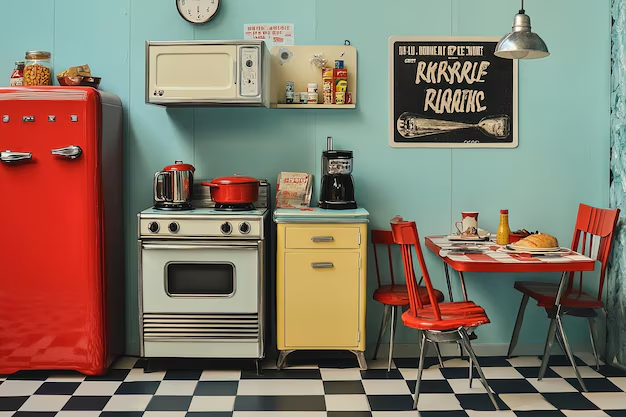How Much Did a Refrigerator Really Cost in 1920? A Deep Dive into the Past
It's fascinating to imagine stepping back in time to 1920, a period bustling with inventions and innovations. One of the household luxuries that began to emerge during this time was the refrigerator. But how much did this marvel of convenience really cost back in the day? Understanding the cost of a refrigerator in the 1920s not only gives us insight into the economic and technological history but also allows us to appreciate the advancements that have transformed our daily lives. This comprehensive guide explores the history, the societal impacts, and the technological advancements of refrigerators from the 1920s to today.
The Historical Context of Refrigeration in the 1920s
Refrigeration Before the 1920s Before electric refrigerators, people relied on iceboxes to store perishable goods. These iceboxes required regular deliveries of ice, which were placed in a compartment of the insulated box to keep food cool. As one could imagine, this wasn't the most convenient solution, and thus the demand for something better was brewing.
The Birth of the Electric Refrigerator The 1920s marked the birth of the electric refrigerator as we know it. Though prototypes and earlier versions existed, it was not until this decade that refrigerators began to appear in households. Companies began mass-producing models that were more affordable and accessible to the average family, fostering a new era of food preservation and safety.
How Much Did a Refrigerator Cost in 1920?
In 1920, the price of a refrigerator was quite high compared to the average income, making it a significant investment for many. Refrigerators cost between $400 to $600—a hefty sum during those times when the average car also cost around $800. This would be equivalent to spending more than $5,000 to $7,000 today when adjusted for inflation. Therefore, owning a refrigerator was considered a luxury.
The Evolution of Refrigerator Prices Over the Decades
The 1930s and 1940s: A Decline in Prices As technology advanced and manufacturing techniques improved, the prices of refrigerators began to decrease. The post-World War II industrial boom also contributed to more affordable pricing and wider distribution, allowing even more households to enjoy these appliances.
The 1950s to 1970s: Booming Popularity With further technological advancements and the rise of suburban living, the refrigerator had firmly cemented itself in the typical household by the mid-20th century. Prices became more competitive, with additional designs and features being introduced.
Modern Day: Affordable Efficiency Today, refrigerators are not only affordable but are also significantly more energy-efficient. A wide range of models are available to suit different needs, from compact options for small spaces to large, feature-packed models for modern kitchens.
Technological Advancements and Their Impact on Costs
Innovation and Efficiency Refrigerators have seen a host of improvements since their inception. The introduction of more efficient compressors, better insulation, and digital thermostats has made today's appliances vastly superior. These innovations have helped reduce costs over time both for manufacturers and consumers.
Environmental Considerations Modern refrigerators are designed with environmental impact in mind. The shift to eco-friendly refrigerants and energy-efficient models help households reduce their carbon footprint and utility bills. Government incentives for energy-efficient appliances further make these options more appealing and accessible.
The Societal Impact of Refrigeration
Changing the Kitchen Landscape The advent of the refrigerator changed how kitchens were designed. As a staple appliance, it influenced the size and layout of the kitchen, allowing for better organization and food preservation.
Shifts in Consumer Habits With the ability to store food for extended periods, shopping habits shifted. People could buy in bulk, reducing the need for frequent trips to the market. This change contributed to the rise of supermarkets and the decline of small local grocers.
Influence on Diet and Health Refrigeration enabled long-term preservation of vegetables, meat, and dairy, enabling a more varied diet. The ability to safely store produce significantly reduced foodborne illnesses and improved overall public health.
Key Takeaways and Consumer Tips
📉 Historical Cost: The cost of a refrigerator in 1920 was a luxury, around $400 to $600 at the time, which was a substantial amount for most families. Today, this equates to over $5,000 to $7,000 when adjusted for inflation.
💡 Technological Growth: Progress in technology has drastically reduced prices and increased the efficiency of refrigeration units. This has turned a luxury item into a household staple.
🏡 Societal Shifts: The widespread availability and affordability of refrigerators have transformed family diets, kitchen designs, and even shopping habits over the past century.
♻️ Environmental Impact: Modern refrigerators use advanced technology to minimize their environmental footprint, making them more energy-efficient than ever before.
The journey of the refrigerator from a luxury item in the 1920s to a household necessity today is a testament to technological progress and shifts in societal norms. As you ponder the trajectories of historical innovations, whether it's in technology or economics, it’s important to appreciate how these transformations shape our everyday lives. Understanding the historical context and progression of household appliances not only enriches our perspective on consumer products but also enhances our appreciation for the comforts and conveniences they bring to our daily living.
